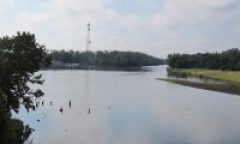Another assignment from the tenth grade English class that inspired “Venus” was to write a pantoum. The format, with repeated lines in different stanzas, struck me as rather silly, but I discovered that I was able to write several about planets and ended up deciding to make a complete set of the five classically-known planets that I think are fairly nice.
“The Classical Planets”
Spring 2003 in New Carrollton, Maryland
Mercury
Small Mercury,
a tiny rock,
close to the sun,
most hard to see.
A tiny rock,
it trails the sun,
most hard to see,
and leads it, too.
It trails the sun,
a tiny speck,
and leads it, too,
in the bright glare.
Small Mercury,
close to the sun,
a tiny speck,
in the bright glare.
Venus
Venus is the
brightest of all,
planet of clouds,
bright inner world.
Brightest of all,
leading the sun,
bright inner world,
following it.
Leading the sun,
the morning star;
following it,
the evening star.
Venus is the
planet of clouds;
the morning star,
the evening star.
Mars
Red world called Mars,
a ruddy speck,
a rocky world,
the Earth’s brother.
A ruddy speck,
brighter than stars;
the Earth’s brother,
colder, smaller.
Brighter than stars,
a world like Earth,
colder, smaller,
frozen and dry.
Red world called Mars,
a rocky world,
a world like Earth,
frozen and dry.
Jupiter
Great Jupiter,
the largest world,
bright in our sky,
with many moons.
The largest world,
planet of gas,
with many moons,
colorful disk.
Planet of gas,
with telescope,
colorful disk,
four moons are seen.
Great Jupiter,
bright in our sky,
with telescope,
four moons are seen.
Saturn
Frozen Saturn,
huge world of gas,
slow-moving world,
with icy moons.
Huge world of gas,
far from the sun,
with icy moons,
orange Titan.
Far from the sun,
telescope shows
orange Titan,
encircling rings.
Frozen Saturn,
slow-moving world,
telescope shows
encircling rings.
